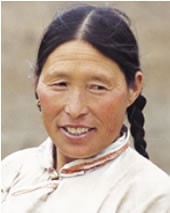The cornerstone of emerging Tibetan civilization was the Yarlung Valley area, about 80 kilometers (49 mi.) southeast of Lhasa. There, according to tradition, the union of a monkey and a she-devil created the Tibetan people. Around AD 600, the warrior-king Namri Gampo began the work of unifying the clans of Tibet. It was his son, Songtsen Gampo, who consolidated the empire and established Tibet as a military power to be reckoned with. Sikkim was nominally independent, although always under Indian influence, until it was annexed in 1975 and integrated into India. The Bhots from Tibet began entering Sikkim in the thirteenth century. The Nepalese did not come until the nineteenth century, but now they make up the great majority of Sikkim's population.
We know very little about the Groma. Most anthropological and linguistic sources do not mention them. It is probable that the Groma have been counted as part of the Tibetan nationality in China and may be culturally and ethnically indistinguishable from other Tibetans in the region. The Chinese authorities have included many distinct language groups under the Tibetan nationality, based primarily on their adherence to Tibetan Buddhism.
The Groma lead typical Tibetan lives. They herd yaks, sheep, and goats. Groma women do most of the work. The men often spend their days drinking and gambling with their friends.
Tibetan Tantric Buddhism dominates the Groma. Devoted pilgrims often undertake pilgrimages to holy sites (such as Mt. Kailas).
There are no known Christians today among the Groma. The little mission work that has focused on the area invariably resulted in severe persecution. "Converts did not easily forget the Christian convert who was sewn into a fresh yak skin by merciless shaman priests and placed in the broiling sun until the contraction of the skin squeezed the life out of his frame." In 1997 neighboring Sikkim counted 250 churches, but almost all the believers were ethnic Nepalis. The north district where the Groma live is completely unreached.
Without the guidance of Christ, these people will be lost in this life and the life to come. They need someone to go to them as Christ-bearers.
Pray for the Lord to intervene in their families, calling people to his side.
Pray for loving workers.
Pray for their hearts to be drawn to the Lord of lords.
Pray for a church planting movement to thrive in their communities.
Scripture Prayers for the Groma in China.
Operation China, Asia Harvest, Copyrighted © Used with permission
| Profile Source: Joshua Project |

























